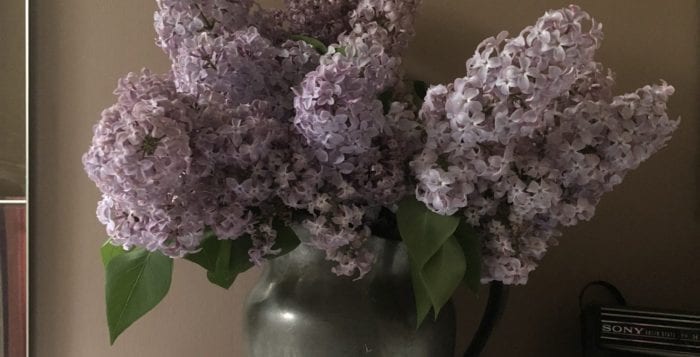By Kyrnan Harvey
My wife cut a large bunch of lilac flowers yesterday and stuffed them in a pewter pitcher. We inherited an old shrub when we moved to East Setauket. English ivy was growing up its gnarly stems, a young black cherry was growing right through the clump and bittersweet had twisted itself up into the crown. There were only a couple blooms the first May here — the common lilac, Syringa vulgaris — but I immediately freed it and cut out cracked branches and each year it has been more bountiful.
Lilacs are deer-proof and otherwise very tough and durable shrubs that present wonderful colors and scents to the early spring garden. Most are in bloom for the second Sunday in May, but if you plant a few different types — early, mid, and late varieties — you can have that lilac scent in your garden — and home — for four weeks.
This week the earliest, the hyacinthiflora hybrids, may be about faded and finished. If you see a Syringa x hyacinthiflora label on a shrub in a garden center it will be a good variety: dark “Royal Purple” or reddish “Pocahontas” or “Maiden’s Blush.” Add one each year if you have the space. I planted an “Angel White” two years ago but so far it has been shy of flower.
Last year I discovered the gorgeous “Declaration,” with reddish tints in the purple, at a wholesale nursery. I gave one to mom and planted one myself. My son’s school bus driver apparently has a good eye for an unusual color so I got her one too. The common vulgaris lilac is not easily discerned from hybrids, but they flower a little later. I have my eye out for “Beauty of Moscow” (pink buds, white flowers), for “Primrose” (creamy yellow, most strongly perfumed), and for “Wonderblue,” but there are dozens of varieties, only a few of which are readily available commercially. Just avoid buying a plant merely labeled S. vulgaris, because it might be just a little too ordinary and there are so many good cultivars to seek out. My old stomping ground, the New York Botanical Garden, has an astounding collection, cataloged online. Hurry there and take notes.
A week or so after the common lilac, the so-called Canadian lilacs flower. Bred originally in Ottawa by a Miss Preston they are hybrids labeled S. x prestoniae. “Donald Wyman” has been readily available for as long as I can remember, and maybe “Red Wine,” but that’s about all.
Extend the lilac season with S. patula “Miss Kim” and S. meyeri “Palibin.” Known as Korean lilacs, they are both dwarfer than the old-fashioned varieties. “Miss Kim” is readily available, “Palibin” less so, though it has caught on in recent years. “Miss Kim” is a valuable addition for its flowering season well past all others, except the badly scented tree lilac.
“Palibin” has been a favorite of mine for a long time. It doesn’t get much taller than five or six feet and it spreads broadly, rooting in. I have dug up pieces for years and planted them in clients’ gardens. It flowers profusely in light shade, doesn’t get powdery mildew, and is twiggy with small leaves.
All the other varieties must have tons of sun. Even then, they might be shy of flowering, especially when still young. Avoid high-nitrogen fertilizer. Very old shrubs too can disappoint with flower production, and, moreover, be overgrown eyesores. Every few years you should cut to the ground a third of the gnarliest old stems, which encourages fresh new growth, and reduces the shrubs to better scale. Do this directly after flowering, and give them lime. Or — if you burn logs in your fireplace — spread the ash around your lilacs.
Kyrnan Harvey is a horticulturist and garden designer residing in East Setauket. For more information, visit www.boskygarden.com.





